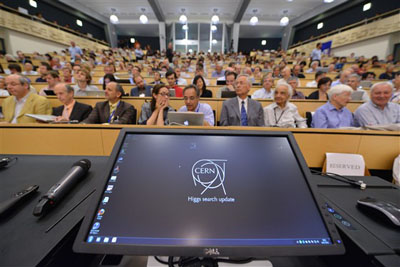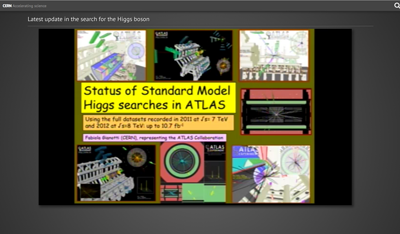This track is an example of simulated data of a decay path of the Higgs boson that may be observed at the LHC when it started taking data in 2008. The Higgs boson is produced in the collision of two protons and quickly decays into four muons. Image b CERN
Scientists from the Large Hadron Collider (LHC) at the European Organization for Nuclear Research in Geneva, Switzerland, this morning revealed they may have finally found the long sought-after Higgs boson particle.
This morning at CERN they have been revealing if they are closer to solving the riddle that has been puzzling the particle physics community for decades and which could revolutionise the scientific field, paving the way for a new physics, as well as our understanding of how the universe was formed.
At CERN this morning, scientists presented the ATLAS and CMS particle physics experiments’ latest results from 2011 and 2012 data in the search for the elusive ‘God particle’ using the Large Hadron Collider.
According to CERN, both experiments reveal strong indications for the presence of a new particle, which could be the Higgs boson, in the mass region around 126 gigaelectronvolts (GeV).
However, CERN said the results presented today are preliminary, as the data from 2012 is still under analysis. The organisation expects to publish the complete analysis around the end of July.

Physicists at CERN this morning. Image by CERN
The LHC is a gigantic scientific instrument near Geneva, where it spans the border between Switzerland and France about 100 metres underground. The particle accelerator is used by physicists to study the smallest-known particles, the building blocks of all things.
The Higgs boson is the only particle predicted by the Standard Model of particle physics that has not yet been seen by experiments.
Today, CERN declared that the experiments have found hints of the new particle. The physicists have been trawling through data that has been gleaned by analysing trillions of proton-proton collisions from the LHC.
The Standard Model is the theory that physicists use to describe the behaviour of fundamental particles and the forces that act between them. It describes the ordinary matter from which we, and everything visible in the universe, are made.
CERN said the Standard Model of particle physics predicts a Higgs boson would decay into different particles, which the LHC experiments then detect.
CERN director for Research and Computing, Sergio Bertolucci, said the organisation now has more than double the data it had last year.
This year the LHC was optimised so scientists at CERN could finally determine whether the Higgs boson exists or not.

You can watch the live webinar from CERN, which started at 8am.